What Changes In Behaviors Will Be Required Of People To Exploit The Potential Of The Smart Grid?
A smart grid is an electricity network/filigree enabling a ii-fashion menstruum of electricity and data whereby smart metering is oft seen as a first step.
Smart grids – equally a concept – became known over a decade agone and are essential in the digital transformation of the electricity sector. An introduction with definitions, trends and essential characteristics of smart grids.
A smart grid is an electricity network enabling a two-fashion flow of electricity and data with digital communications engineering science enabling to detect, react and pro-act to changes in usage and multiple bug. Smart grids accept self-healing capabilities and enable electricity customers to become active participants.
Big data analytics and IoT technologies are important technology drivers in smart grids whereby analytics shift to the edge, as in edge computing. Smart grids leverage more technologies but aren't just about Information technology nor even technologies.
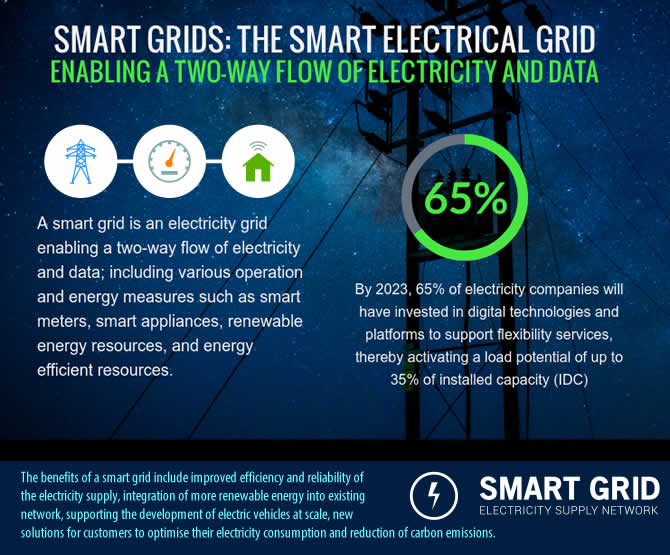
A smart grid serves several purposes and the motility from traditional electric grids to smart grids is driven by multiple factors, including the deregulation of the energy market, evolutions in metering, changes on the level of electricity production, decentralization (distributed energy), the advent of the involved 'prosumer', irresolute regulations, the ascent of microgeneration and (isolated) microgrids, renewable energy mandates with more than energy sources and new points where and purposes for which electricity is needed (eastward.k. electrical vehicle charging points).
An electric filigree or electric grid is a network to evangelize electricity from the producer(southward) and places where information technology'due south generated and transformed (power plants and substations) to the final destinations where electricity is 'consumed': households, businesses, various facilities and the consumer in general.
In practice it is a highly interconnected network with several components such every bit substations, manual lines and wiring, distribution lines, transformers and more than.
Smart grid and filigree modernization – what's in a name?
Do note that some people in the industry don't talk about smart filigree anymore. They run across that term as referring to a beginning stage where advanced metering infrastructure (AMI) initiatives were deployed with first-generation smart meters.
Grid ecosystem players have diverse challenges in the decentralization of energy product and send.
They prefer to speak nearly power filigree modernization, for example, as that is what it's actually nigh with far more elements than smart metering, sending data in two directions and calculation power to the grid in the opposite direction. However, although many countries, regions, states etc. already took such smart metering initiatives a decade agone there are still several where this is only really starting. In many countries the challenges of filigree players are mainly seen in the decentralization of the production of energy and the transport of information technology.
For IoT companies such as AllThingsTalk the challenge that energy and grid players ask them to assistance resolve is the connection of a multitude of meters and normalization of resulting data, enabling to roll out faster and in an automated fashion every bit founder Tom Casaer explains in an interview.
The smart filigree compared to traditional electricity grids – the essence and differences
Traditional electricity grids had about no storage capabilities, they are demand-driven and have a hierarchical structure. In an electricity network voltage is gradually lowered so the electricity can be used past these unlike consumers: from manual voltage levels to distribution voltage levels to service voltage levels (in reality it's both gearing up and downwards and thus a chip more than complex).
Typically, a stardom is made between transmission (transmission grid: loftier and extra high voltage) and distribution (distribution grid: lower voltage), where different wiring and cabling systems come in the moving-picture show. The purpose of an electrical grid is to make certain that electricity is e'er provided when and where needed, without interruption – and herein lie many challenges where a smart filigree tin already offer solutions/answers.
Given the complication and the multiple challenges that tin can arise such equally the consequences of severe weather weather condition, damage by wild animals, human demolition and other external factors and internal factors (problems with equipment failure and crucial assets) managing a grid is very circuitous and a dedicated field for experts who also demand to consider the choices regarding energy regulations and sustainability initiatives past governments.
In smart grids, self-healing capabilities enable to automatically detect and answer to filigree problems and to ensure quick recovery later on disturbances.
The 2-way flow of electricity and data that is the essential feature of a smart filigree enables to feed information and data to the various stakeholders in the electricity market which can be analyzed to optimize the grid, foresee potential issues, react faster when challenges arise and build new capacities – and services – equally the power landscape is changing.
The electricity market, the consumption of electricity, regulations, demands of various stakeholders and the very production of electricity are all changing. So, smart grid initiatives exist across the globe, albeit sometimes with dissimilar approaches and goals.
While smart grid still refers to the bi-directional transmission of data and electricity (with prosumers and organizations generating electricity likewise), the significant and reach of the term has broadened given the many possibilities enabled past this important change and ever more technologies used in a context of smart grid deployments.
This includes, every bit previously mentioned, IoT technologies (electrical grids are highly sensor-intensive operations since long before anyone used the term IoT), big data and avant-garde analytics with artificial intelligence and machine learning on top, ample communication standards used to send data from one point to another (east.thou. from smart meters to utility companies) and more technologies (digital twins, for example) which we encounter popping up in the digital transformation of utilities and in Industry 4.0.
Every bit said, nosotros as well must mention border computing here. Edge computing and edge analytics play an important function in utilities overall.
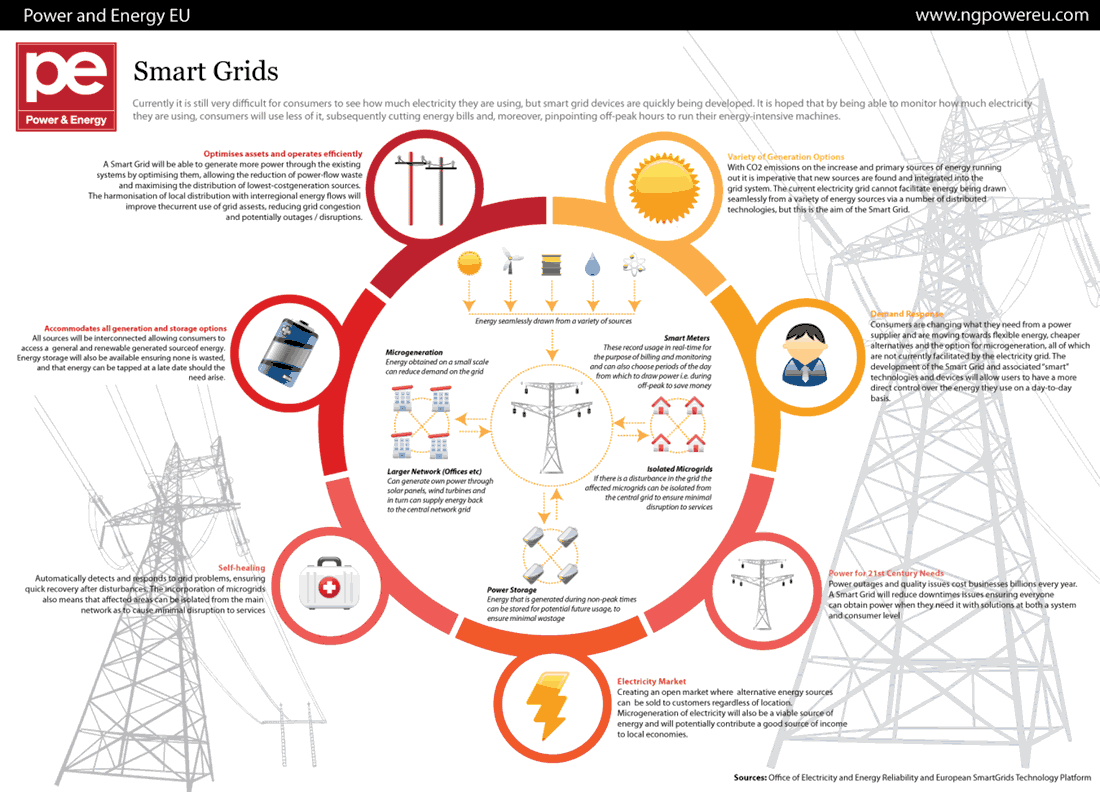
Smart grids: more than smart meters and advanced metering infrastructure
Every bit mentioned, i of the outset and mayhap chief aspects of smart filigree initiatives, when people starting time hear virtually them, business metering and and so-chosen smart meters. Smart meters are the side by side stage in an evolution that started decades agone and led to the first smart grid technologies such as automatic metering and, next Advanced Metering Infrastructure.
Microgrids play an of import function in building a depression-carbon future because they bring resilience to the main grid, optimize energy costs, permit for renewable energy hosting, increase electric vehicle integration, and improve energy accessibility.
Nevertheless, a smart filigree is nearly much more than but smart metering and some other elements include the distribution lines and substations (substation automation and, increasingly, digital substations), technologies and mechanisms to prevent power outages and ensure ability quality (availability, reliability, etc.), the integration of energy from various sources with an increased focus on 'green free energy', smart power generation, sensing along manual lines, power system automation, the inclusion of microgeneration whereby specially organizations and larger facilities can generate their own power and supply it to the central network filigree (on top of prosumers), better and more power storage capabilities, ways to enhance security, alternative transmission methods to save on precious metals and the design of more than modern and stable electric grids in countries and areas where old grids need replacement.
Currently there is a lot of focus on self-healing filigree capacities, microgrids and distributed free energy resources (DER), the communication architectures and technologies in grids and the usage of smart grid technologies/solutions/approaches in regions with older electricity grids that suffer from outages and poor power quality.
"One of the primary characteristics of a smart filigree is its ability to self-heal" confirms Julio Cesar Martins of Schneider Electrical (that has a channel program, called EcoXpert for certifications in critical ability, substation automation etc. and is one of the leading players in the smart grid market place).
Pointing to FLISR applied science (fault location, isolation, and service restoration) he adds that self-healing capabilities minimize blackouts because they allow for continuous cocky-assessments that inspect, analyze, react to, and automatically respond to bug.
This is made possible through the widespread deployment of smart sensors and other intelligent devices and automated controls that check and evaluate the status and condition of the network to identify abnormalities and issues he states.
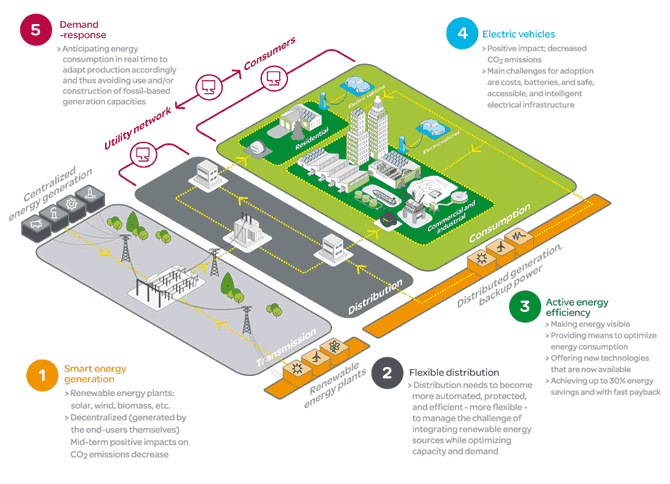
Flexibly is another keyword. According to the previously mentioned past 2023, 65% of electricity companies will take invested in digital technologies and platforms to back up flexibility services, thereby activating a load potential of up to 35% of installed capacity.
Using the power of analytics, a smart filigree typically includes Industrial IoT use cases in areas such every bit asset optimization, predictive maintenance, the mentioned self-healing and whatever method to get (parts of) grids up once more in case of issues or needed maintenance or external factors and ways to right and optimize power quality while making certain demand for electricity is met in the most optimal way with energy savings and environmental mandates never being far away.
Centralized power generation is increasingly giving way to decentralized every bit new technologies go along to allow for different forms of power generation, storage, and transmission.
The prosumer plays an important role in the efforts of free energy companies and diverse players in the utilities value concatenation such as energy retailers whereby customer-centricity and improving client experience are fundamental. In 2019 utilities/free energy retailers double their investments in artificial intelligence to amend convenience, customization, and control for clients, thus enhancing client experience says IDC.
Smart grids shouldn't simply lead to less power waste material and raise competitiveness in the electricity sector merely as well aim to put the consumer more in command (whereby free energy companies also hope to see less unpaid bills).
Decentralized energy generation and the smart grid
As mentioned, one of the master changes in the electricity industry is the ascension of so-called decentralized energy generation and of microgrids/microgeneration.
Decentralized free energy generation essentially means that more and more energy gets generated (and stored) in various ways that are closer to the customer that needs the free energy. If consumers of energy in the broadest sense generate their ain free energy more frequently this de facto means that less money is made in various 'college' levels of electrical grids.
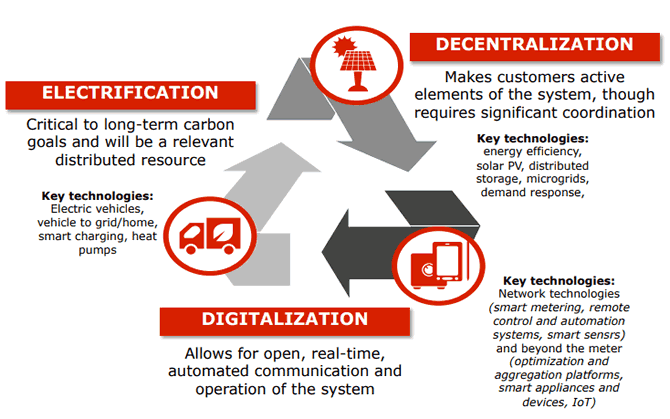
"Closer" doesn't necessary mean in terms of distance. If a company has power-generating means where it is located, then chance is indeed high nothing else is physically closer. Yet, you can perfectly imagine situations where a ability plant could be physically very close as well. What matters is the ability to integrate the various resource whereby decentralized energy in full general refers to the energy produced closer to the point of usage instead of at some large plant from where information technology is sent across the national grid.
By 2023, 65% of electricity companies will have invested in digital technologies and platforms to support flexibility services, thereby activating a load potential of up to 35% of installed chapters (IDC)
"Centralized power generation is increasingly giving mode to decentralized as new technologies continue to allow for dissimilar forms of power generation, storage, and transmission" says Emmanuel Lagarrigue. Decentralization is aught less than a revolution in how we generate, store, move, and consume free energy he adds.
One of the challenges is integrating all this but also sending additional capacity that might be created in a decentralized fashion to the grid whereby companies – and people – go sellers of energy as well as buyers. You tin can imagine that this isn't the easiest task in the smart grid equation. Isolated microgrids too enable to minimize bear upon of potential disruption.
What is a smart grid? Smart filigree definitions and some challenges to address
A smart filigree has been defined equally (a network of) self-sufficient systems enabling the integration of power generation sources of any blazon and/or scale to the electrical grid that reduces the workforce and aims to offer safe, reliable, high-quality and sustainable electricity to consumers and organizations akin.
The aspect of workforce reduction is indeed important as well. It is expected that smart grids will demand very little workers as they become the true self-sufficient systems they are aimed to exist. It is less emphasized in definitions offered by national and international instances working on smart grids whereby mainly the benefits are addressed (some more than challenges are mentioned at the bottom of this article).
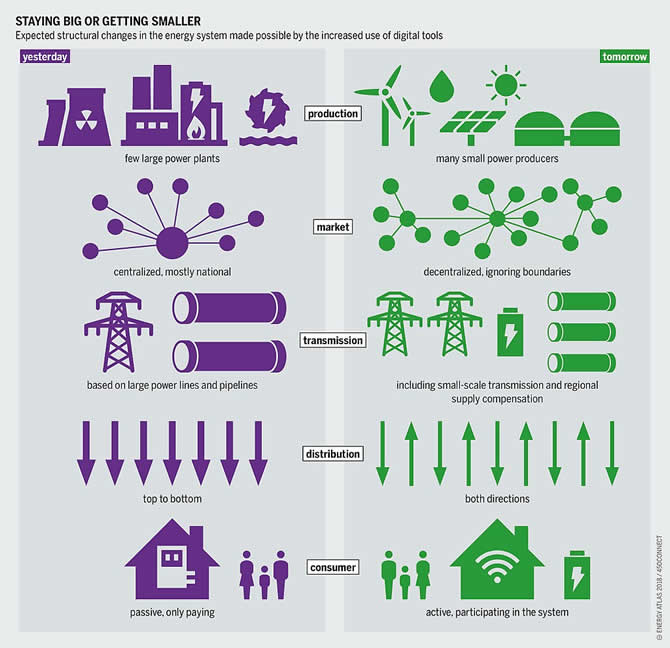
Another definition, from Debashish Chakraborty: "A smart grid is an intelligent digitized energy network delivering energy in an optimal mode from source to consumption".
"This is achieved by integrating data, telecommunications, and power technologies with the existing electricity system. Information technology introduces a two-mode dialogue where electricity and data can be exchanged between a utility and its customers. It's a developing network of communications, controls, computers, automation and new technologies and tools working together to make the grid more efficient, more reliable, more than secure and greener".
And of course, we can't forget those national and supranational instances (electricity grids can be regional, national, international etc., depending on the region) who accept their smart grid projects/policies.
The EU defines a smart grid as follows: a smart grid is an electricity network that can toll-efficiently integrate the behavior and actions of all users continued to it – generators, consumers and those that do both – to ensure economically efficient, sustainable power system with low losses and high levels of quality and security of supply and safety.
The benefits of a smart filigree include improved efficiency and reliability of the electricity supply, integration of more renewable free energy into existing network, supporting the development of electric vehicles at scale, new solutions for customers to optimize their electricity consumption and reduction of carbon emissions.
While the European union (PDF downloads) recognizes that there are elements of smartness in several parts of electrical power grids information technology distinguishes between existing grids and smart grids equally follows: "the difference betwixt a today's grid and a smart filigree of the futurity is mainly the grid's adequacy to handle more complexity than today in an efficient and effective way".
According to the EU a smart grid employs innovative products and services together with intelligent monitoring, control, communication, and self-healing technologies to:
- Amend facilitate the connexion and functioning of generators of all sizes and technologies;
- Let consumers to play a function in optimizing the operation of the system;
- Provide consumers with greater information and options for how they use their supply;
- Significantly reduce the environmental impact of the whole electricity supply system;
- Maintain or even better the existing high levels of system reliability, quality and security of supply;
- Maintain and improve the existing services efficiently.
Like smart grid definitions exist in other regions through the world where smart grid initiatives be which is the case for most countries, obviously including the United states of america.
The U.Due south. Department of Energy describes "the Smart Grid" (as the overall smart filigree initiative in the Usa is called) as representing an unprecedented opportunity to motility the energy industry into a new era of reliability, availability, and efficiency that will contribute to economic and environmental health.
Information technology sums up some benefits associated with the Smart Grid (over again, the initiative, only you can expand it to smart grids overall):
- More efficient transmission of electricity;
- Quicker restoration of electricity later power disturbances;
- Reduced operations and direction costs for utilities, and ultimately lower power costs for consumers;
- Reduced peak demand, which will also assistance lower electricity rates;
- Increased integration of large-scale renewable energy systems;
- Better integration of customer-owner power generation systems, including renewable energy systems;
- Improved security.
Smart grids: some boosted challenges
Obviously, at that place are besides challenges regarding the motion to a smart grid. Some were addressed earlier in this overview. Additional ones include consumer concerns (privacy and personal data protection) and cybersecurity.
In countries where smart meter initiatives have started we often see resistance from consumers (whereby ofttimes the installation of a smart meter in the stop becomes an option; in other countries refusing leads to financial consequences or, let's say accepting means a financial reward).
A second challenge is certainly the overall cybersecurity attribute which is typical in all industrial environments where digitization and digital transformation are ongoing, data go fundamental and IT and OT converge (IT stands for it, OT for operational technology).
Smart grids will increase network flexibility by the development of additional intelligence (e.g. temperature command of transformers, existent fourth dimension thermal monitoring of cables, etc) integrated within network equipments and will improve the existing communication systems (EU Commission Task Strength for Smart Grids)
Additional challenges in smart grids include regulatory changes, the complexity in integrating sources, systems and partnerships between various players in a deregulated marketplace, the local situation whereby a selected number of large companies oftentimes still boss and irresolute attitudes amid prosumers.
The goal of this article was to innovate smart grids and explain the essence of the smart filigree concept (we call it a concept as there is no existent smart grid however). However, at that place is of course more to it given the sheer complexity of electric grids, the involved components and the many stakeholders.
Smart grids patently fit in a broader digital transformation of utilities and, given these many stakeholders (including local and higher-level government) and the fact everything is connected also touches several other so-called 'smart' areas, from smart manufacturing and smart cities to the smart dwelling house and smart buildings.
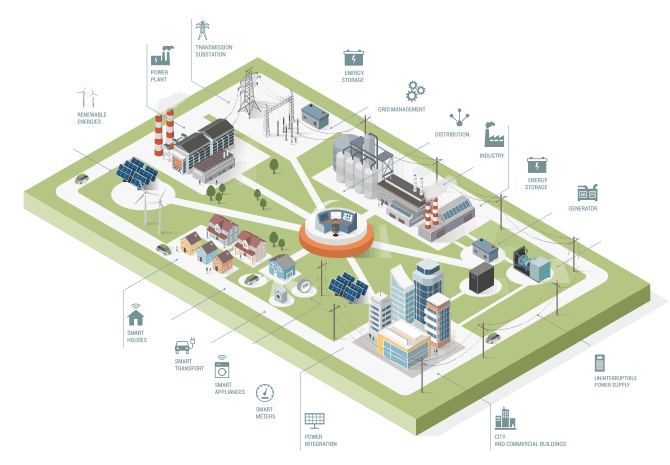
From advanced metering infrastructure to distributed free energy resources
A terminal idea: as said the smart filigree concept isn't new. Moreover, it'southward a journey and gradual processes, a spectrum encompassing many possible dissimilar steps and challenges. Withal it'south clear that we've moved far beyond the early days of avant-garde metering.
Smart grids include various functioning and energy measures such as smart meters, smart appliances, renewable free energy resources, and energy efficient resources.
Zach Pollock describes the evolution on the 'smart filigree journeying' since the term start popped up well: "The first wave of grid investments occurred in the late 2000s nether the banner of smart grid engineering, resulting in utility-owned, front-of-the-meter assets like avant-garde metering infrastructure (AMI) and distribution automation devices. Today, grid modernization has evolved to be more inclusive of customer preferences and desires. In many geographies, this has translated to infrastructure and process improvements that have facilitated the integration of distributed free energy resource (DER)".
As is explained here, distributed energy resource (DERs) are electricity-producing resources or controllable loads that are directly connected to a local distribution arrangement or connected to a host facility within the local distribution system.
DER systems typically employ renewable energy sources, including small-scale hydro, biomass, biogas, solar power, wind power, and geothermal power, and increasingly play an important part for the electric power distribution system.
Source: https://www.i-scoop.eu/industry-4-0/smart-grids-electrical-grid/
Posted by: jacksondebefors.blogspot.com


0 Response to "What Changes In Behaviors Will Be Required Of People To Exploit The Potential Of The Smart Grid?"
Post a Comment